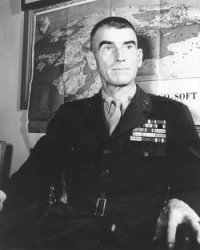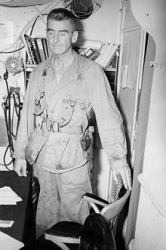
 |
|
|
||
|
Evans Fordyce Carlson |
||||
|
Engagements: • Occupation of Nicaragua (1912 - 1933)• World War I (1914 - 1918)• World War II (1941 - 1945) |
||||
| Biography: | ||||
|
Evans Fordyce Carlson Evans Fordyce Carlson was born on 26 February 1896 in Sidney, NY, the son of a Congregationalist minister. He ran away from his home in Vermont in 1910 and two years later disguised his age to enter the U.S. Army. Service in the U.S. Army During his first enlistment in the Army, he served in the Philippines and Hawaii. He was discharged in 1916 as a "top" or First Sergeant. Less than a year later, he returned to the Army and participated in the Mexican Punitive Expedition. During World War I, he saw action in France, and was awarded a Wound Chevron (later exchanged for the Purple Heart) for wounds received in action. He was commissioned a Second Lieutenant in May 1917, and made Captain of Field Artillery in December 1917. He served in Germany with the Army of Occupation and was discharged from the Army in 1921. Marine Corps Career Carlson's famed career as a Marine started in 1922 when he enlisted as a Private. In 1923, he was again commissioned a Second Lieutenant. After duty at MCB Quantico, VA, he sailed for Culebra, Puerto Rico in 1924 and remained there five months before being ordered to the West Coast for duty with the Pacific Fleet. Applying for aviation training in 1925, he went to Naval Aeronautical Station Pensacola, FL, for instruction, but was subsequently returned to duty with ground units. He served another tour of foreign shore duty from 1927-29 at Shanghai, China. Nicaragua Carlson was ordered to Nicaragua in 1930 as an officer in the Guardia Nacional. A First Lieutenant at the time, he earned his first Navy Cross for leading 12 Marines against 100 bandits in a night attack to break up a threat to his garrison. He was also commended for his actions following the 1931 earthquake at Managua, and for performance of duties as Chief of Police in 1932 and 1933. Friendship with the Roosevelts Returning to the U.S. in 1933, Captain Carlson served as Executive Officer of the Marine Corps Detachment at President Roosevelt's alternative White House and vacation retreat at Warm Springs, GA, where he became closely acquainted with President Franklin D. Roosevelt and his son James. Second and Third China Tours After his Warm Springs tour, Carlson was posted to the 4th Marines in Shanghai. Shortly afterward he was transferred to the Marine Detachment, American Legation, Peiping, China, where he served as Adjutant and studied the Chinese language. In 1936, he returned to the U.S. via Japan. At home he served at Quantico while attending Marine Corps Schools, and studying International Law and Politics at George Washington University in Washington, DC. He went back to China for the third time in 1937 as an official student of the Chinese language and as a military observer with Chinese forces. There he was afforded the opportunity to learn the tactics of the Japanese soldier. He met Edgar Snow in China and read Snow's Red Star Over China. This encounter led him to visit the Chinese Communist Troop Headquarters in northern China, where he met Chinese Communist leaders such as Mao Zedong, Zhou Enlai and Deng Xiaoping. Traveling thousands of miles through the interior of China with the communist guerrillas, often on foot and horseback over the most hazardous terrain, he lived under the same primitive conditions. He was impressed by the tactics used by Chinese Communist guerrillas to fight Japanese troops. When he left China in 1938, he was commended by the Commander-in-Chief of the Asiatic Fleet for his services. He was so impressed with the danger of Japanese aggression in the Far East that in 1939 he resigned his commission as a Captain in order to be free to write and lecture on that subject. When the danger he foresaw neared reality in 1941, he applied to be re-commissioned in the Marine Corps and was accepted with the rank of Major. A year later, in 1942, he was placed in command of the Second Marine Raider Battalion with the rank of Lieutenant Colonel, a new combat organization whose creation he influenced. The organization and discipline of the 2nd Raiders was modeled on that of the Communist Armies he had observed during his time in China. Because of his relationship with President Roosevelt and the president's son, Captain James Roosevelt, a Marine reserve captain who authored a letter to the Commandant of the Marine Corps proposing creation of the Raiders, the Marine Corps authorized the creation of the Raiders despite misgivings about Carlson's philosophy. In the military there is a sharp caste-system divide between officers and enlisted personnel, and even experienced noncommissioned officers were expected to be subservient to even the newest, greenest Second Lieutenant. Carlson's experience in having gone back and forth between officer and enlisted status in both the Army and the Marine Corps convinced him that this was not in the best interests of the service. Carlson saw the Communist approach as superior. Leaders were expected to serve the unit and the fighters they led, not to be served. Responsibility, not privilege, would be the keyword for battalion leadership when the Second Raiders formed up. Using an egalitarian and team-building approach, Carlson promulgated a new way for senior NCOs to mentor junior officers and work with the officers for the betterment of the unit. Even more controversial in concept, Carlson gave his men "ethical indoctrination," designed to "give (his men) conviction through persuasion," describing for each man what he was fighting for and why. Of more lasting importance to the Marine Corps, Carlson also changed the organization of his squads, eschewing an eight-man squad dictated by the Marines in favor of a 10-man squad composed of a squad leader and three 3-man "fire teams," each containing a BAR, a Thompson, and an M1 rifle. Carlson's leadership of the Second Raiders in the Makin Raid, 17 August 1942, earned him a Gold Star in lieu of a second Navy Cross. A second Gold Star was awarded him for heroism and distinguished leadership on Guadalcanal in November and December of that year. On 15 March 1943, the four Raider Battalions were placed under the control of the newly created 1st Raider Regiment, commanded by the former commander of the 3rd Raiders, Col. Harry B. Liversedge. A week later Carlson was relieved as Commander of the 2nd Raiders by Lt. Col. Alan Shapley, an officer of much more orthodox thinking, and made Executive Officer of the 1st Raider Regiment. Within a month, Shapley had reorganized the 2nd Raiders into a traditional organization, and Liversedge then standardized the organization of the four Raider Battalions along the lines of the 1st Raider Battalion, although all adopted the 3-fireteam squad-organization concept pioneered by Carlson, which was soon adopted by the Marine Corps as a whole. Later Service in the Pacific Carlson was soon ordered back to the U.S. for medical treatment of malaria and jaundice, and served as a technical advisor to Walter Wanger's Gung Ho!: The Story of Carlson's Makin Island Raiders (released December 1943). He subsequently returned to Tarawa as an observer. In its November 1943 engagement he was cited for volunteering to carry vital information through enemy fire from an advanced post to division headquarters. He was wounded during the 1944 Saipan operation while attempting to rescue a wounded enlisted radioman from a front-line observation post, and was awarded a Gold Star in lieu of a second Purple Heart. Physical disability resulting from the wounds received on Saipan caused Carlson's retirement on 1 July 1946. He was advanced to the rank of Brigadier General on the retired list at that time for having been specially commended for the performance of duty in actual combat. Medals and Awards Navy Cross (3 Awards) Brigadier General Evans Fordyce Carlson died on 27 May 1947 at Emmanuel Hospital, Portland, OR, as the result of a cardiac ailment. He was 51. Carlson is buried at Arlington National Cemetery in Arlington, VA. He was survived by his wife, Peggy Tatum Carlson, and a son by a previous marriage, Evans C. Carlson. |
||||
| Honoree ID: 2314 | Created by: MHOH | |||
Ribbons
Medals
Badges
Honoree Photos
 |  |  |
 |  |
 |


